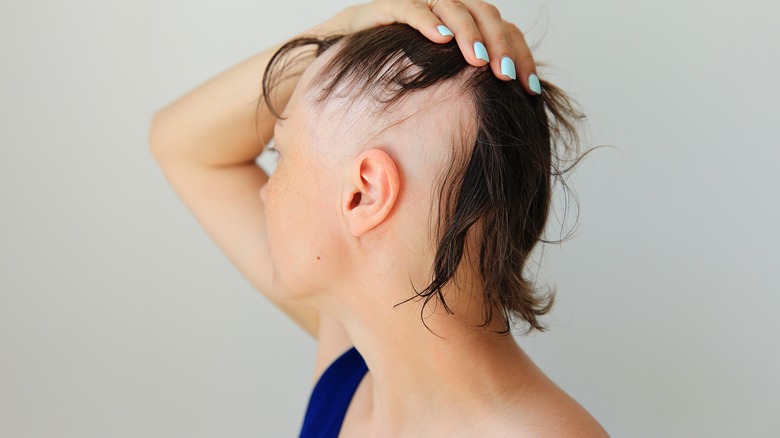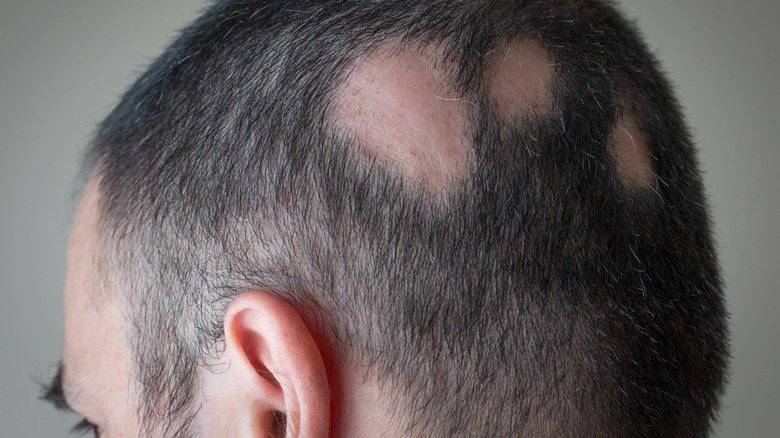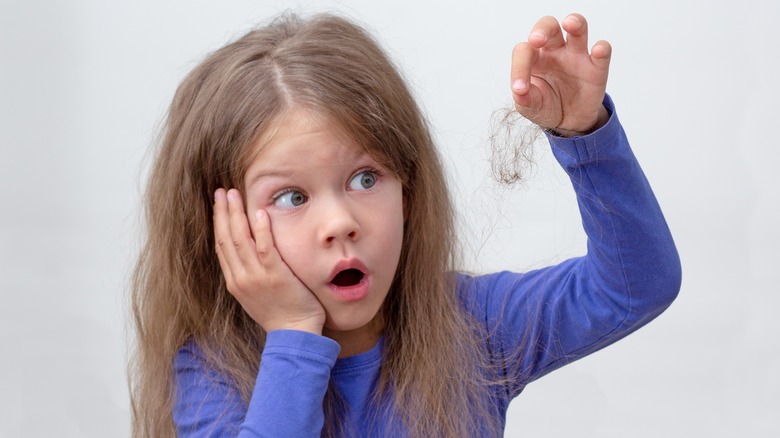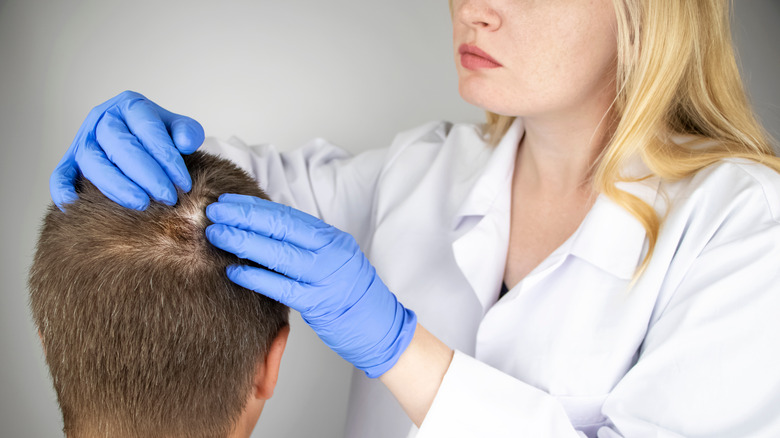What Is Alopecia And What Causes It?
Perhaps you've heard of male pattern baldness, or you may experience thinning of your hair as you age. The medical term for hair loss is alopecia, which includes an array of ways that the body can refute hair growth or even stop hair follicles from functioning altogether (via Mayo Clinic). It's normal to lose strands of hair on a daily basis, but when hair begins to fall out in clumps, patches, or clusters, then there is likely an underlying condition.
Autoimmune conditions are generally attributed with provoking the loss of hair on the head, eyebrows, eyelashes, arms, or elsewhere on the body, per the Cleveland Clinic. When the body's immune system begins attacking itself in a pattern consistent with incorrect functioning, then the underlying condition is called an autoimmune disorder. Alopecia is usually associated with autoimmune disorders attacking the body's hair follicles, though some people experience alopecia due to genetics or medications. Women, men, and children are all affected by alopecia, but to different degrees and in different ways. Here's what you should know about the types of alopecia.
The types of alopecia
There are several types of alopecia, and each subtype has its own unique and identifiable pattern of hair loss, according to WebMD. The word "alopecia" is used as an umbrella term to encompass an array of subtypes that cause hair loss. Androgenic alopecia is the type of alopecia you may often hear called male pattern hair loss, or female pattern hair loss if a woman is affected. This subtype of alopecia is usually attributed to genetics and presents differently in men and women, with men experiencing the retraction of their hairline and loss of coverage in specific areas, while women tend to experience hair that becomes thinner over time rather than changes in their hairline. Of course, there are always exceptions, and alopecia doesn't always appear in the exact same way for any two people.
Alopecia areata is another common type of the hair loss condition that is known primarily for the way that hair falls out in seemingly random patches on the scalp, per Healthline. Alopecia areata can also impact the rest of the body and cause hair loss anywhere. In addition to the scalp, common places that alopecia areata causes patches of hair loss are around the eyes, particularly the eyelashes and eyebrows. When the head experiences complete loss of hair, the type of alopecia is identified as alopecia totalis, and if the entire body loses hair then the subtype is called alopecia universalis.
Alopecia in women and children
Compared to men, who are more prone to male pattern hair loss, aka androgenic alopecia, women and children experience alopecia to a lesser degree, yet with unique subtypes and symptoms (via Healthline). Children are the least likely demographic to experience alopecia, but there are several types with which they can be diagnosed. Pediatric forms of alopecia include ophiasis alopecia, lichen planopilaris, and alopecia areata. The latter subtype, alopecia areata, tends to emerge in adolescence and follow symptomatic paths similar to adult alopecia areata. A fourth type of pediatric alopecia that is common in children diagnosed with the hair loss condition is called tinea capitis, though it is more colloquially known as ringworm of the scalp due to the circular shape the hair loss makes on the scalp, per Children's Health. Unlike other forms of alopecia that cannot be spread to other people, tinea capitis can be contagious.
Women can develop a form of alopecia called postpartum alopecia following childbirth, according to the American Academy of Dermatology Association. Hair loss that occurs post-childbirth can begin soon after giving birth, or it may occur a few months later. Postpartum alopecia is caused by rapidly declining levels of estrogen in the body after pregnancy is over and may be referred to as excessive hair shedding due to the rate at which hair loss occurs. Fortunately, postpartum alopecia resolves on its own and generally subsides within a year after giving birth.
Treatments for alopecia
While there's no magic cure for general hair loss, despite what cosmetic advertisements may try to say, there are ways to manage different types of alopecia. Along with postpartum alopecia that tends to resolve on its own as estrogen levels even out post-childbirth, there's another form of alopecia called telogen effluvium that is brought on by triggers that can also resolve after the triggers are removed, says Alopecia UK. Telogen effluvium is frequently caused by stress, medications, environmental factors, or changing hormones. Embracing ways to reduce and manage stress, such as by meditation or mindfulness, can increase the recovery of telogen effluvium hair loss. Similarly, if the condition is caused by medication, then cessation of the medication can lead to telogen effluvium resolving, as can removing environmental triggers found to be the cause of alopecia.
Yale Medicine reports that treatments for types of alopecia that don't resolve on their own, like alopecia areata caused by genetics or an underlying autoimmune disorder, can be treated with topical creams and ointments, oral prescription medications, and steroid injections. In particular, steroid injections applied to the areas of hair loss can allow hair growth to be restored by subduing the cells from the immune system that are attacking the body's hair follicles. This treatment option is especially effective for alopecia areata and similar subtypes of alopecia. If you have concerns about potential hair loss, always consult with your doctor to determine the underlying cause.



